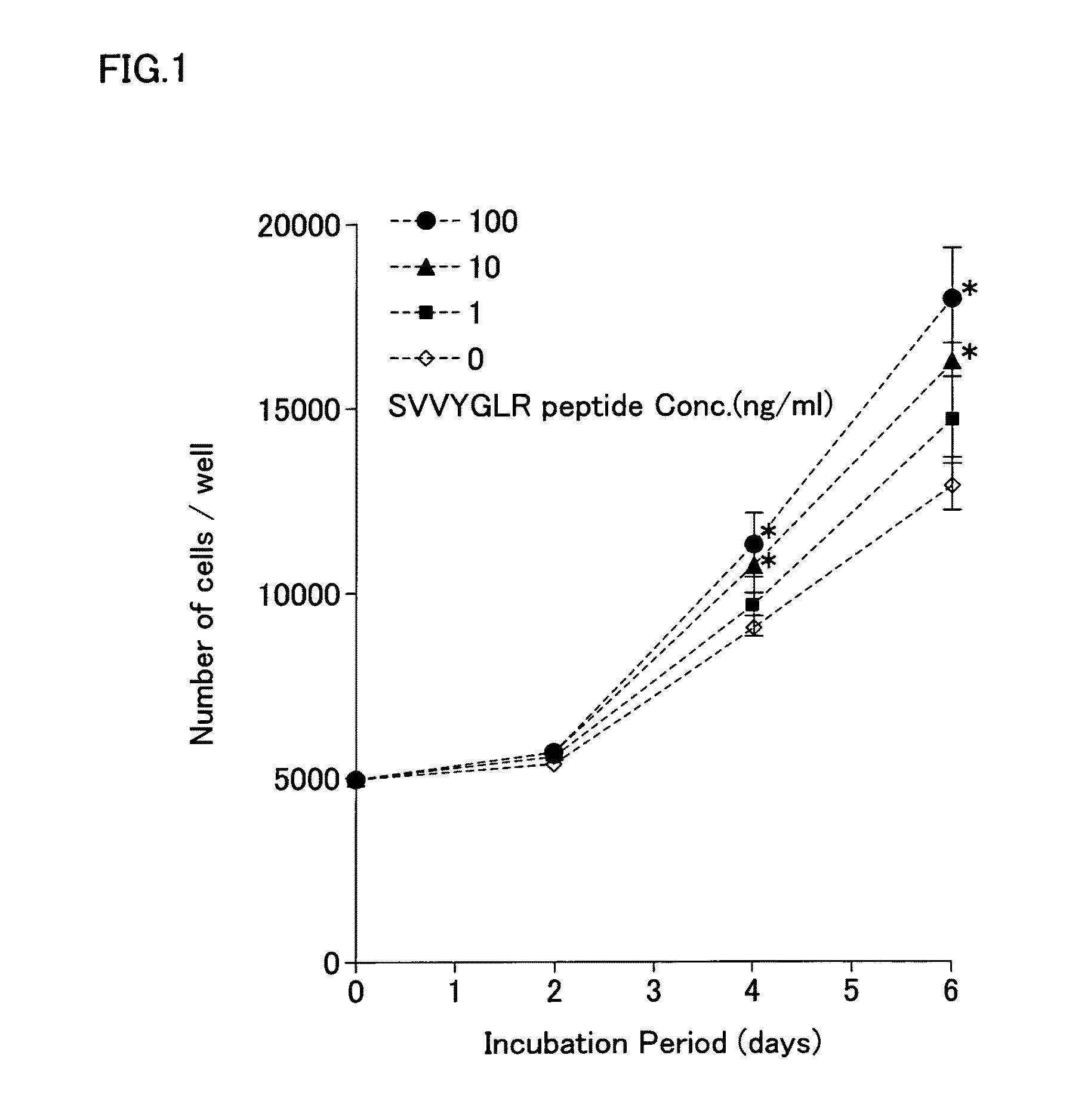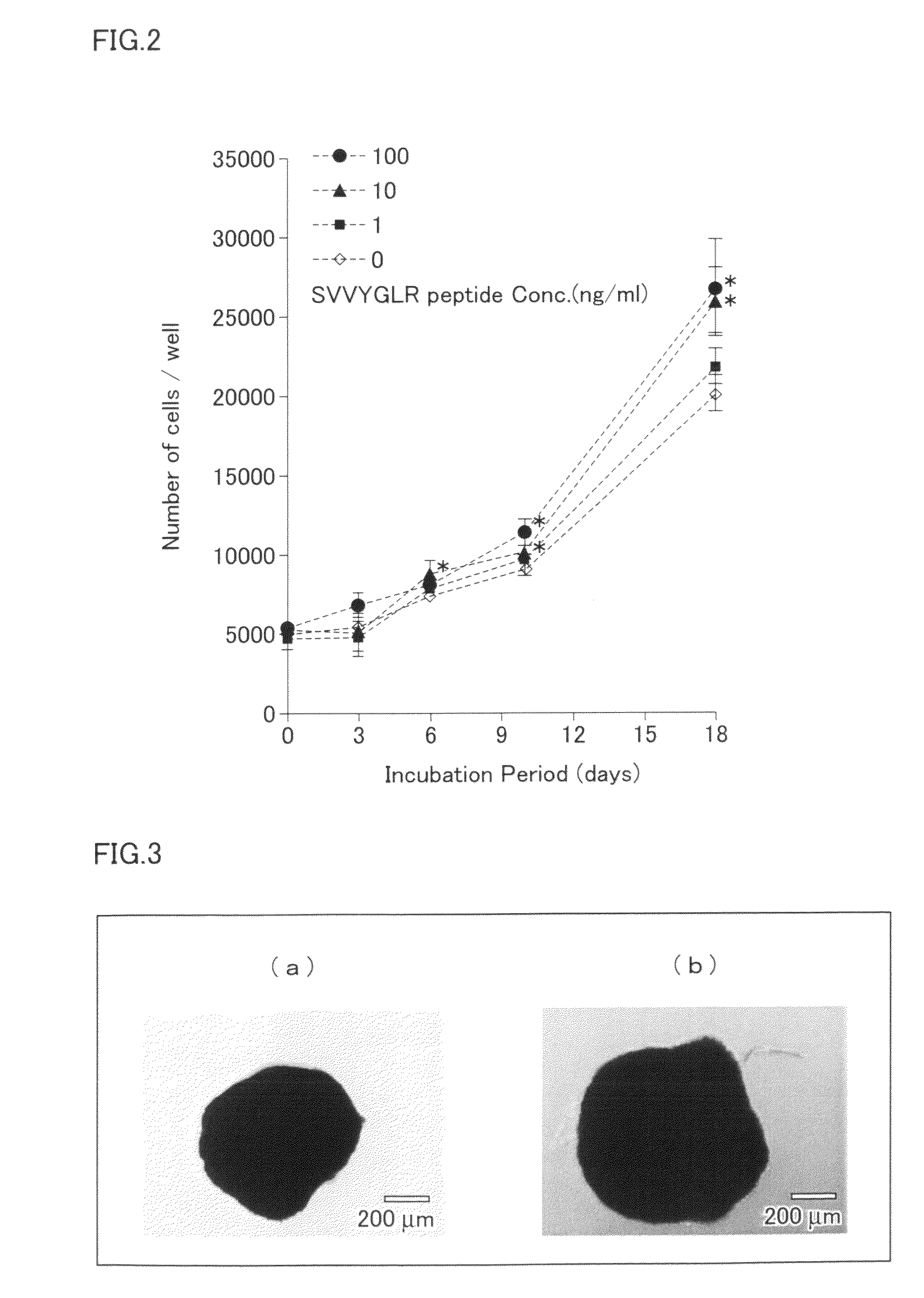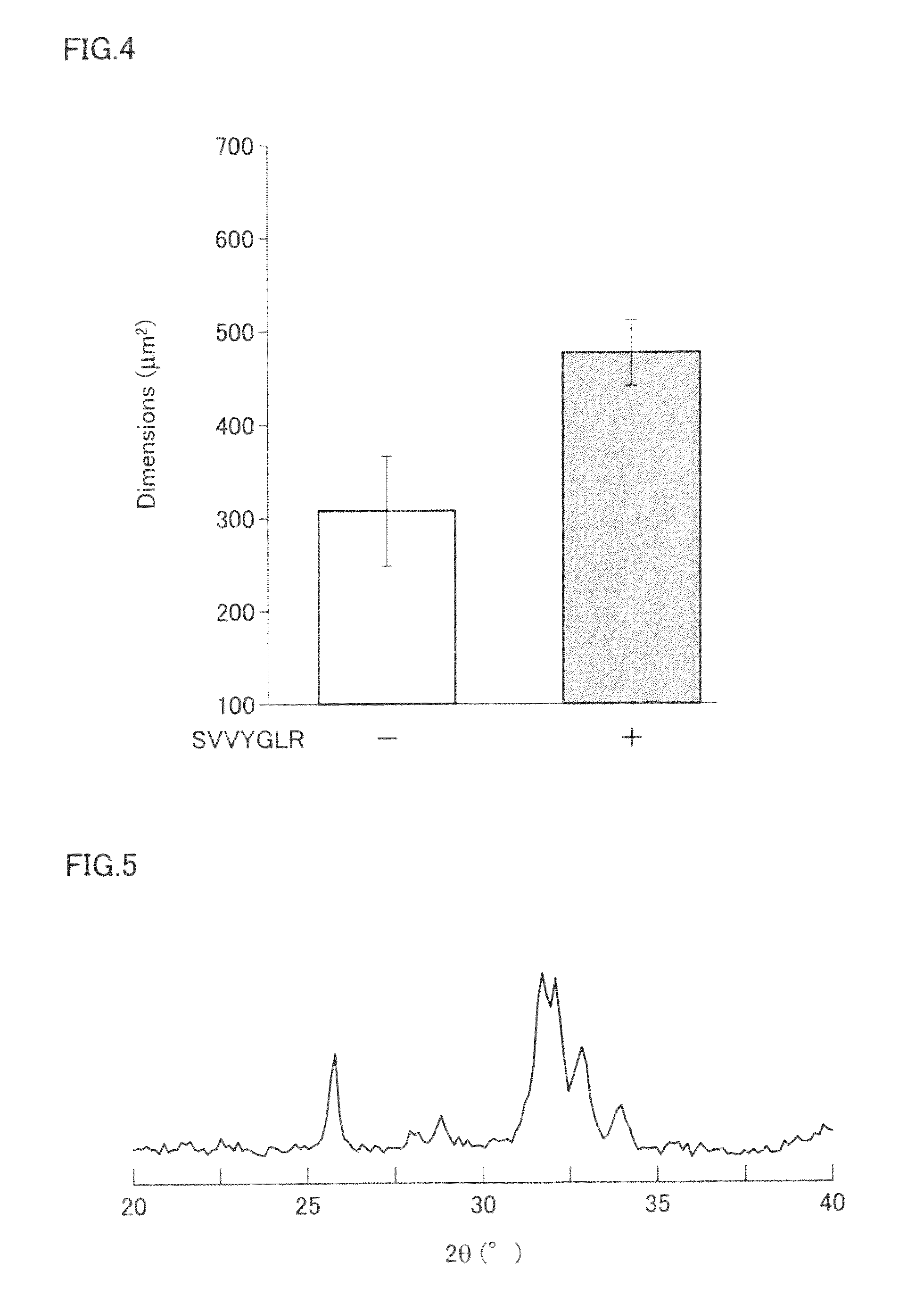Mesenchymal cell proliferation promoter and skeletal system biomaterial
a mesenchymal cell and promoter technology, applied in the field of mesenchymal cell proliferation promoter and skeletal system biomaterial, can solve the problems of not being able to survive without the blood vessels that provide oxygen and nutrients, and the severed surface of the dental pulp being technically difficult to treat, etc., to achieve the effect of promoting regeneration of bone marrow tissue and promoting the proliferation of mesenchymal cells
- Summary
- Abstract
- Description
- Claims
- Application Information
AI Technical Summary
Benefits of technology
Problems solved by technology
Method used
Image
Examples
example 1
Effect Exerted on Proliferating Ability of Mesenchymal Cells by SVVYGLR Peptide (SEQ ID NO: 1)
[0069]An in vitro experiment was conducted to analyze how the SVVYGLR peptide (SEQ ID NO: 1) affected a proliferating ability of mesenchymal cells present in intercellular substances of bone marrow and dental pulp.
[0070]Purchased human bone marrow-derived mesenchymal stem cells (Cambrex BioScience Inc.) were used as the mesenchymal cells of the intercellular substance of bone marrow. Further, “dental pulp cells”, the mesenchymal cells that constitute a main component of dental pulp tissue, were isolated from a lower incisor of a Sprague-Dawley rat (8-week old male) and cultured based on the method of Nakamura H et al. (J Dent Res. 84: 515-520: 2005), and used for the experiment.
[0071]These cells were seeded into a 96-well cell culture plate at a rate of 5,000 cells / well, and the number of cells under the presence of the SVVYGLR peptide (SEQ ID NO: 1) (0 to 100 ng / ml) was measured by using W...
example 2
Effect Exerted on Three-Dimensional Proliferation of Mesenchymal Cells by SVVYGLR Peptide (SEQ ID NO: 1)
[0076]A pellet culture experiment was conducted to analyze how the SVVYGLR peptide (SEQ ID NO: 1) affected the mesenchymal cells when the mesenchymal cells clump together three-dimensionally over a long time.
[0077]The mesenchymal cells were isolated from thigh bone marrow of a Sprague-Dawley rat (8-week old male), and cultured in a pellet culture with initial count of 50,000 cells based on the method of Tsutsumi S et al. (Biochem Biophys Res Commun. 288:413-419:2001). The incubation was carried out with a culture medium prepared in such a manner that dexamethasone (100 nM, Sigma-Aldrich), ascorbic acid (50 μg / ml, Sigma-Aldrich), ITS+ premix (100 times diluted, BD Biosciences), and recombinant human transforming growth factor-β1 (10 ng / ml, PeproTech EC) were added to α-MEM (high glucose: Nacalai Tesque, Inc). The SVVYGLR peptide (SEQ ID NO: 1) (100 ng / ml) was added to the culture m...
example 3
Producing Carbonate Apatite-Collagen Sponge Containing SVVYGLR Peptide (SEQ ID NO: 1)
[0081]Carbonate apatite was synthesized at 60±1□, pH7.4±0.2. First, 0.5 L of Ca(CH3COO)2H2O solution (100 mmol / L) and 0.5 L of NH4H2PO4 solution containing (NH4)2CO3 (60 mmol / L) were added to 1 L of acetic buffer (1.3 mol / L) under stirring. After being stirred for 3 hours, the mixture was allowed to stand for 24 hours at 25□. And then the mixture was filtered to isolate the carbonate apatite. The isolated carbonate apatite was washed with distillated water, and dried at 60□. In this way, the carbonate apatite was obtained.
[0082]An X-ray diffraction of the obtained synthetic carbon apatite was performed by using X-ray diffractometer (DX1, Shimazu Corporation). FIG. 5 shows an X-ray diffraction pattern of the synthetic carbonate apatite. Comparing this with a hydroxyapatite having a high-crystallized pattern, it is recognized that the synthetic carbonate apatite has a low-crystallization apatite patte...
PUM
| Property | Measurement | Unit |
|---|---|---|
| concentration | aaaaa | aaaaa |
| viscosity | aaaaa | aaaaa |
| concentration | aaaaa | aaaaa |
Abstract
Description
Claims
Application Information
 Login to View More
Login to View More - R&D
- Intellectual Property
- Life Sciences
- Materials
- Tech Scout
- Unparalleled Data Quality
- Higher Quality Content
- 60% Fewer Hallucinations
Browse by: Latest US Patents, China's latest patents, Technical Efficacy Thesaurus, Application Domain, Technology Topic, Popular Technical Reports.
© 2025 PatSnap. All rights reserved.Legal|Privacy policy|Modern Slavery Act Transparency Statement|Sitemap|About US| Contact US: help@patsnap.com



